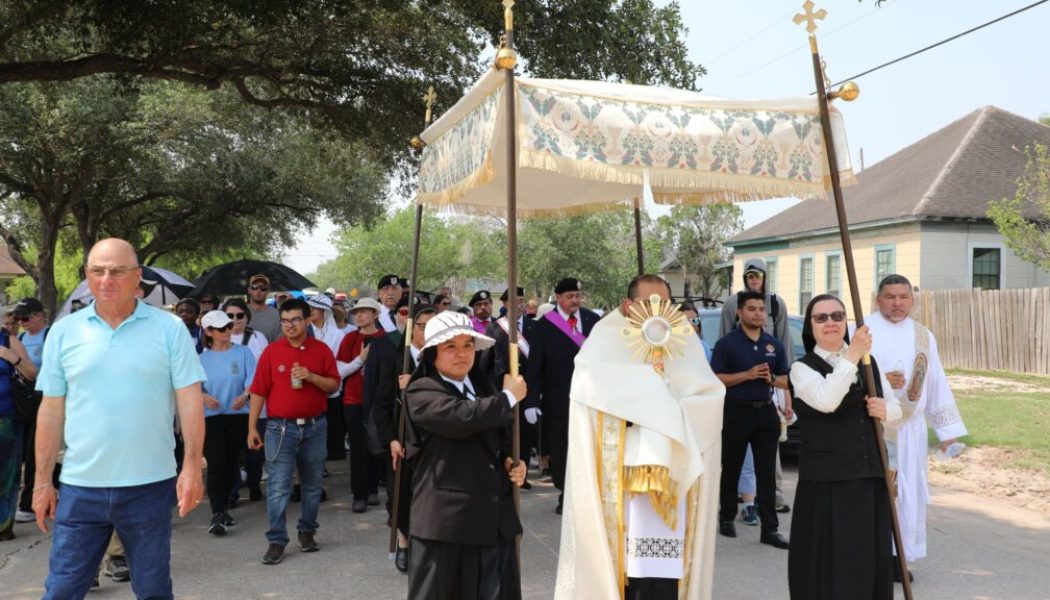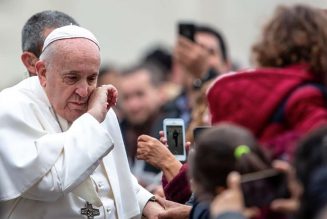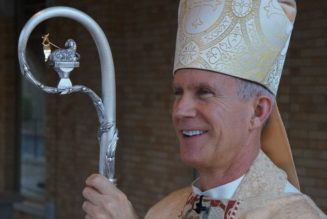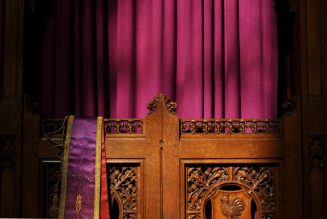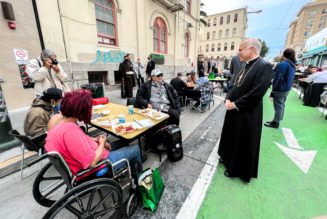
(OSV News) — In their first week, pilgrims on the National Eucharistic Pilgrimage have faced blisters, a busted toe and thunderstorms, but those “hiccups” along the routes are “all gifts from God,” said Jack Krebs, a perpetual pilgrim on the pilgrimage’s St. Junipero Serra Route.
As the pilgrims make their way to Indianapolis with the Eucharist, Krebs said he is amazed at the number of people showing up for processions or adoration. In San Francisco, where the Serra Route launched May 18, an estimated 4,000 people walked in a Eucharistic procession over the Golden Gate Bridge following Mass May 19.
Krebs has witnessed “the excitement that the people are showing for the Eucharist,” he said during a May 22 media conference, “and I really do trust that it is having a bigger impact on their hearts.”
On May 18-19, Krebs and 22 other young adults chosen to be perpetual pilgrims, along with seven seminarians and a rotating cadre of chaplains, began the pilgrimage in four groups from Brownsville, Texas; New Haven, Connecticut; Northern Minnesota; and San Francisco.
Over the next eight weeks, they are journeying — often by foot but always with the Eucharist — to Indianapolis, where the first National Eucharistic Congress in 83 years takes place at Lucas Oil Stadium July 17-21.
The pilgrimage and the congress are highlights of the National Eucharistic Revival, a three-year initiative the U.S. bishops launched in 2022 to inspire deeper love for and understanding of Jesus’ real presence in the Eucharist.
In California, Serra Route pilgrims began in San Francisco at the Mission Dolores Basilica, one of the missions established in the 1700s by the route’s patron, the Spanish Franciscan missionary priest Junipero Serra. After the milestone of crossing the Golden Gate Bridge, they continued their pilgrimage May 20-24 in the Diocese of Sacramento, California. Sacramento, the state’s capital, and its adjacent river, were named for the Blessed Sacrament.
On May 23, the Serra Route pilgrims visited Folsom Prison; this portion of their journey has included several boat processions down the river, and will end with a boat procession across Lake Tahoe into the Diocese of Reno, Nevada, where they will be May 24-26.
Pilgrims on its Marian Route began at the Mississippi River’s headwaters in the Diocese of Crookston, Minnesota, and continued through the state in the Diocese of Duluth and into the Diocese of St. Cloud, before spending May 24-31 in the Archdiocese of St. Paul and Minneapolis, where they will join a 5-mile procession down a historic St. Paul avenue May 27.
For the first four days, they were accompanied by Crookston Bishop Andrew H. Cozzens, who led the development of the national congress and pilgrimage while serving as the chairman of the U.S. Conference of Catholic Bishops’ Committee on Evangelization and Catechesis from 2020-2023, and who is now board chairman of National Eucharistic Congress, Inc., the organization created to oversee the congress.
On the St. Elizabeth Seton Route, which began in the Diocese of Hartford, Connecticut, pilgrims took a boat May 19 to the Diocese of Bridgeport. On May 22, they entered the Archdiocese of New York, where they joined Auxiliary Bishop Edmund J. Whalen for a bilingual Mass in English and Spanish, followed by a Holy Hour that led into all-night adoration.
On May 26, they will process from St. Patrick’s Cathedral through Manhattan to the Brooklyn Bridge for Benediction before continuing into the Diocese of Brooklyn.
At St. Cyril and Methodius Oratory on Bridgeport’s East Side, where the pilgrims stopped on a procession route, Canon Francis Xavier Altiere told the Fairfield County Catholic, the Diocese of Bridgeport’s monthly newspaper, that “in a world that’s very indifferent or even just ignorant of the faith, a public procession like this is a good opportunity also to share the faith.”
“It’s important for the Catholics of Bridgeport,” the oratory’s rector, a member of the Institute of Christ the King Sovereign Priest, added. “But whether they know it or not, it’s also very important for the non-Catholics of Bridgeport.”
Pilgrims on the St. Juan Diego Route spent May 19-22 in the Diocese of Brownsville, leaving after a closing Mass with Bishop Daniel E. Flores at the beloved Basilica of Our Lady of San Juan del Valle – National Shrine in San Juan, Texas. They are spending May 22-27 in the Diocese of Corpus Christi, Texas, which, like Sacramento, is named for the Eucharist — “Corpus Christi” is Latin for “the body of Christ.”
At a May 19 Mass, Bishop Flores — a board member of the National Eucharistic Congress Inc., and its USCCB liaison — talked about St. John’s vision of the Celestial City “where the lamb is in his throne” in the Book of Revelation, and said that the church’s mission is to go to that city.
“What we do as people today is gather around the throne of the Lamb, which is the altar of sacrifice,” Bishop Flores said. “It helps us understand why it is important for us Catholics to have the Mass — because God is preparing us, because without this we become disoriented.”
Shayla Elm, one of the Juan Diego Route perpetual pilgrims who is originally from Minot, North Dakota and currently lives in Denver, Colorado, noted that Brownsville’s 10-mile procession had a local flair, with lively expressions of personal faith and Texas hospitality, as they followed the Eucharist in a monstrance on an altar affixed to an open-air roofed trailer hauled by a moving white pickup truck.
“It was very much Brownsville’s pilgrimage today,” she said. “It was just really beautiful to see how personal the Lord is with the people here.” As she and the other pilgrims journey from the south to Indianapolis, Elm said she hoped that every city they go through embraces the pilgrimage as their own.
On all routes, the perpetual pilgrims are collecting prayer intentions, asking people at each stop to share them in writing or via a website at tinyurl.com/NEP-prayers.
Pilgrims said they were already getting glimpses into the pilgrimage’s impact. On the Seton Route, perpetual pilgrim Natalie Garza said a policeman who assisted them in the Diocese of Bridgeport told them that the experience has inspired him to bring his family back to church.
For her, the tremendous amount of time with Jesus concealed under the appearance of bread has prompted reflection on “the profundity and mystery that it is to say that we eat God,” she said while in Greenwich, Connecticut.
“I find myself staring at him in what looks like bread, though it is actually him, and marveling at how outrageous the claim is that we can eat God — this idea that the God of the universe doesn’t even just become creation … but something that was created by creation,” Garza said. “That is the thing that God uses as his vehicle, so this is the idea — that God himself becomes food and we eat him — (that) is remarkable to me.”
The pilgrims hope that that kind of wonder and reverence spreads to the people who encounter the Eucharist during the pilgrimage, even those who don’t understand that the Eucharist is Jesus’ body, blood, soul and divinity.
“It’s big,” Krebs said of the pilgrimage. “And lives are going to be changed.”
Maria Wiering is senior writer for OSV News. Contributing to this story were Marietha Góngora V., and Rose Brennan with the Fairfield County Catholic from Bridgeport, Connecticut.
The National Eucharistic Congress’ perpetual pilgrims are accepting prayer requests in person and online.
